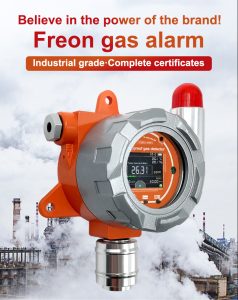Air pollution is a major environmental and public health issue, with significant impacts on human health, ecosystems, and the economy. According to the World Health Organization (WHO), air pollution is responsible for an estimated 7 million premature deaths worldwide every year. In order to address this pressing issue, it is essential to have accurate and reliable air quality monitoring systems in place. Gas sensors play a crucial role in these monitoring systems, providing real-time data on the concentration of various air pollutants. In this article, we will explore the role of gas sensors in advancing air quality monitoring and the recent advancements in gas sensor technology.

The Role of Gas Sensors in Air Quality Monitoring
Gas sensors are devices that detect and measure the concentration of specific gases in the air. They are an essential component of air quality monitoring systems, providing real-time data on the levels of pollutants such as carbon monoxide (CO), nitrogen dioxide (NO2), sulfur dioxide (SO2), ozone (O3), and particulate matter (PM). This data is used to assess air quality, identify sources of pollution, and develop strategies to mitigate the impacts of air pollution.
Gas sensors are used in a variety of applications, including ambient air monitoring, indoor air quality monitoring, industrial emissions monitoring, and vehicle emissions testing. They are also used in personal air quality monitors, allowing individuals to track their exposure to air pollutants in real-time. Gas sensors can be deployed as standalone devices or integrated into larger air quality monitoring networks, providing comprehensive coverage of air pollution levels in a given area.
Advancements in Gas Sensor Technology
In recent years, there have been significant advancements in gas sensor technology, leading to improvements in accuracy, sensitivity, and reliability. These advancements have been driven by the increasing demand for more effective air quality monitoring solutions, as well as the rapid development of sensor technologies such as nanotechnology, microelectromechanical systems (MEMS), and machine learning.
One of the key advancements in gas sensor technology is the development of low-cost, portable sensors that can be deployed in large numbers to create dense air quality monitoring networks. These sensors are often based on metal oxide semiconductor (MOS) technology, which offers high sensitivity to a wide range of gases and can be mass-produced at low cost. This has enabled the deployment of sensor networks in urban areas, providing detailed insights into air pollution levels at a neighborhood or even street level.
Another important advancement is the integration of gas sensors with wireless communication technologies, allowing for real-time data transmission and remote monitoring. This enables air quality monitoring systems to be more responsive and adaptive, providing timely information to policymakers, public health officials, and the general public. In addition, advancements in data analytics and machine learning have made it possible to process and analyze the large volumes of data generated by gas sensor networks, leading to more accurate and insightful assessments of air quality.
Challenges and Future Directions
Despite the advancements in gas sensor technology, there are still challenges that need to be addressed in order to further advance air quality monitoring. One of the key challenges is the need for improved calibration and validation of gas sensors, as well as the development of standardized testing protocols to ensure the accuracy and reliability of sensor data. In addition, there is a need for greater collaboration between sensor manufacturers, researchers, and regulatory agencies to ensure that gas sensors meet the requirements for air quality monitoring applications.
Looking to the future, there are several promising directions for the advancement of gas sensor technology and air quality monitoring. One of these is the development of multi-gas sensors that can detect and measure a wide range of air pollutants simultaneously, providing comprehensive insights into air quality. Another direction is the integration of gas sensors with other environmental sensors, such as humidity and temperature sensors, to provide a more holistic view of environmental conditions. Furthermore, the use of advanced materials and manufacturing techniques, such as graphene-based sensors and 3D printing, holds promise for the development of more sensitive, durable, and cost-effective gas sensors.

Conclusion
Gas sensors play a crucial role in advancing air quality monitoring, providing real-time data on air pollution levels that is essential for understanding and addressing this pressing environmental and public health issue. Recent advancements in gas sensor technology have led to improvements in accuracy, sensitivity, and reliability, as well as the development of low-cost, portable sensors and wireless communication technologies. Looking to the future, there are promising directions for further advancements in gas sensor technology, including the development of multi-gas sensors, integration with other environmental sensors, and the use of advanced materials and manufacturing techniques. By continuing to advance gas sensor technology, we can improve our ability to monitor and mitigate air pollution, ultimately leading to a healthier and more sustainable environment for all.
 : +86 155 8830 2704
: +86 155 8830 2704 : jxdziot@gmail.com
: jxdziot@gmail.com
